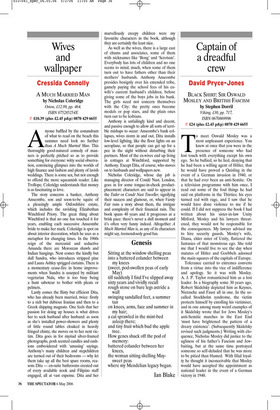Wives and wallpaper
Cressida Connolly
A MUCH MARRIED MAN by Nicholas Coleridge Orion, £12.99, pp. 464, ISBN 075285254X ✆ £10.39 (plus £2.45 p&p) 0870 429 6655 Anyone baffled by the conundrum of what to read on the beach this summer need look no further than A Much Married Man. This thoroughly good-natured comedy of manners is perfectly pitched so as to provide something for everyone: witty social observation, convincing glimpses into the worlds of high finance and fashion and plenty of lavish weddings. There is some sex, but not enough to offend the more squeamish reader. Like Trollope, Coleridge understands that money is as fascinating as love.
The story concerns a banker, Anthony Anscombe, son and soon-to-be squire of a pleasingly ample Oxfordshire estate, which includes the ravishing Elizabethan Winchford Priory. The great thing about Winchford is that no one has touched it for years, enabling each successive Anscombe bride to make her mark. Coleridge is spot on about interior decoration, which he uses as a metaphor for changing times. In the 1960s reign of the mercurial and seductive Amanda there are Moroccan shawls and Indian hangings. Next comes the kindly but dull Sandra, who introduces stripped pine and Laura Ashley sprigged curtains. There is a momentary cease-fire in home improvements when Sandra is usurped by militant vegetarian Nula, who is too busy being a hunt saboteur to bother with pleats or pelmets.
Lastly comes the flinty but efficient Dita, who has already been married, twice: firstly to a rich but dubious Iranian and then to a Greek shipping magnate. One feels that her passion for doing up houses is what drives her to seek husband after husband: as soon as she’s installed power-showers and plenty of little round tables cloaked in heavily fringed chintz, she moves on to her next victim. Dita goes in for myriad silver-framed photographs, posh scented candles and cushions embroidered with ‘amusing’ sayings. Anthony’s many children and stepchildren are turned out of their bedrooms — why let them take up all the best spare rooms, reasons Dita — en-suite bathrooms created out of every available nook and Filipino staff engaged, all at vast expense. Dita and her marvellously creepy children were my favourite characters in the book, although they are certainly the least nice.
As well as the wives, there is a large cast of chums and associates, some of them with nicknames like ‘Bong’ and ‘Scrotum’. Everybody has lots of children and no one seems to mind, much, when some of them turn out to have fathers other than their mothers’ husbands. Anthony Anscombe presides benignly over his extended tribe, gamely paying the school fees of his exwife’s current husband’s children, before giving some of the boys jobs in his bank. The girls need not concern themselves with the City: the pretty ones become models or pop stars, and the plain ones turn out to be lesbians.
Anthony is unfailingly kind and decent, and passive enough to allow all sorts of terrible mishaps to occur: Anscombe’s bank collapses, wives storm in and out, Dita installs low-level lighting, like the floor lights on an aeroplane, so that people can get up for a pee in the night without disturbing their partners. Most of the ex-wives end up living in cottages at Winchford, supported by Anthony. Except Dita, of course, who moves on to husbands and wallpapers new.
Nicholas Coleridge, whose day job is managing director of Condé Nast, London, goes in for some tongue-in-cheek productplacement: characters are said to appear in the Tatler or Condé Nast Traveller, signifying their success and glamour, or, when Vanity Fair runs a story about them, the intrigue and complexity of their financial ruin. The book spans 40 years and it progresses at a brisk pace: there’s never a dull moment and it’s often very funny indeed. Altogether A Much Married Man is, as any of its characters might say, tremendously good fun.














































 Previous page
Previous page